Hardwood floors are one of the most beautiful and valuable features of a home, but they are also highly vulnerable when exposed to water. Even a small leak can leave behind moisture that seeps into the wood, leading to warping, buckling, or permanent staining if not addressed quickly. Acting fast can make the difference between saving your flooring and paying for a costly replacement.
That’s where professional hardwood floor drying comes in. Unlike simple surface cleaning, this process removes moisture deep within the wood and subfloor to prevent long-term damage. Knowing what steps to take, and when to call for expert help, is essential for keeping your floors in top condition after a water incident.
Identify the Source of Water

The first step in protecting hardwood is stopping the water at its source. Whether it’s a burst pipe, appliance leak, overflowing sink, or storm damage, preventing more water from entering the area is absolutely critical. Until the source is controlled, any restoration effort will be temporary at best and may even result in repeated damage.
Once the leak is under control, immediate cleanup can begin. Acting quickly prevents water from spreading into adjoining rooms, seeping into the subfloor, or weakening structural elements of the home. In cases where large amounts of water are involved, such as a flooded basement, professional basement flood cleanup services ensure that excess moisture is removed safely and efficiently. This fast action helps protect hardwood floors and limits the long-term costs of repair.
Remove Standing Water Quickly

Time is the enemy when it comes to hardwood. Even a small amount of standing water can begin seeping into wood fibers within minutes, and the longer it remains, the deeper it penetrates into the boards. Once moisture reaches the subfloor, the drying process becomes much more complicated and expensive. That’s why water should be removed as soon as possible using pumps, wet vacuums, or absorbent materials designed for heavy-duty cleanup.
Prompt action not only helps protect the visible surface of your hardwood but also reduces the risk of hidden damage such as cupping, swelling, or mold growth beneath the flooring. Mold, in particular, can spread quickly in damp environments, creating health risks in addition to structural problems. By acting fast while awaiting professional restoration assistance, homeowners can greatly improve the chances of saving their floors and avoiding a full replacement.
Control Indoor Humidity Levels
Even after surface water is gone, excess humidity can continue damaging hardwood. Dehumidifiers, fans, and open windows (when weather allows) help maintain proper airflow and reduce moisture in the air. This is especially important during Cleveland’s humid summers, when floors can remain damp for extended periods.
Keeping humidity under control helps wood planks return to their normal size and prevents new mold growth. Restoration professionals use commercial-grade dehumidifiers to speed up this process.
Inspect for Hidden Moisture

Moisture often lingers beneath the surface, where it’s invisible to the eye and impossible to detect without specialized tools. Even if the top of the floor feels dry, water can remain trapped in the subfloor, between planks, or inside wall cavities. Over time, this hidden moisture can cause warping, mold growth, or structural weakening that homeowners won’t notice until the damage is much more severe.
That’s why professionals rely on tools like moisture meters, hygrometers, and infrared cameras to identify exactly where water remains. Skipping this step is one of the most common reasons problems reappear weeks or months later. Thorough inspections ensure that every layer of the flooring system, along with surrounding materials, is completely dry. Homeowners who attempt DIY cleanup often miss these hidden pockets, leaving their property at risk for recurring damage.
Call in Professional Drying Services
DIY methods can only go so far. Professional restoration companies bring specialized equipment designed to remove deep moisture without causing additional harm to the wood. This includes targeted drying mats, powerful air movers, and industrial dehumidifiers.
Certified technicians also know how to balance drying speed with wood preservation, since overly rapid drying can cause cracks or splits. This level of expertise helps save flooring that might otherwise need replacement.
Prevent Future Water Damage

Once the floor is dry, prevention becomes the priority. Regularly inspecting plumbing, sealing gaps around appliances, and maintaining gutters all help reduce the risk of future leaks. Homeowners should also keep an eye out for early warning signs such as musty odors or discolored boards.
Even with preventive steps, emergencies can still happen. That’s why having access to a trusted 24/7 water damage restoration service is so important. Quick response combined with proactive maintenance ensures your hardwood floors stay protected and your home remains safe.
How TriGuard Restoration Can Help
At TriGuard Restoration, we specialize in saving hardwood floors after water damage. Our 24/7 emergency team serves Cleveland and communities across Northeast Ohio, using advanced drying equipment and certified techniques to stop damage in its tracks. From moisture detection to full hardwood floor drying, we restore your flooring safely and effectively while guiding you through the insurance process.



